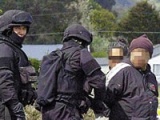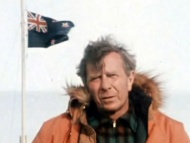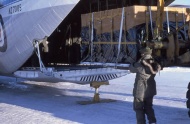Events In History
-
 15 October 2007'Anti-terror' raids in Urewera
15 October 2007'Anti-terror' raids in UreweraCiting the Terrorism Suppression Act, police arrested 18 people in nationwide raids linked to alleged weapons training camps near the eastern Bay of Plenty township of Rūātoki. Read more...
-
 29 July 1981Police baton anti-tour protesters near Parliament
29 July 1981Police baton anti-tour protesters near ParliamentUp to 2000 anti-Springbok tour protesters were confronted by police who used batons to stop them marching up Molesworth St to the home of South Africa's Consul to New Zealand. Read more...
-
 28 December 1929'Black Saturday' - NZ police open fire in Apia
28 December 1929'Black Saturday' - NZ police open fire in ApiaNew Zealand had been granted a mandate over the former German colony following the First World War. Growing Samoan calls for independence came to a head during a Mau demonstration in Apia which left 12 people dead. Read more...
Articles
The 1912 Waihi strike

On 'Black Tuesday', 12 November 1912, in the midst of a bitter six-month strike by miners in the small New Zealand goldmining town of Waihi, striker Fred Evans was killed - one of only two fatalities in an industrial dispute in New Zealand's history.
- Page 1 - 'Black Tuesday'On 'Black Tuesday', 12 November 1912, in the midst of a bitter six-month strike by miners in the small New Zealand goldmining town of Waihi, striker Fred Evans was killed - one of
Responding to tragedy

How police responded to the disasters, particularly Tangiwai, Wahine and Erebus
- Page 1 - Police response to disasterHow police responded to the disasters, particularly Tangiwai, Wahine and Erebus
1981 Springbok tour

For 56 days in July, August and September 1981, New Zealanders were divided against each other in the largest civil disturbance seen since the 1951 waterfront dispute. The cause of this was the visit of the South African rugby team – the Springboks.
-
Page 4 – Stopping the 1973 tour
Keeping sport and politics separate was becoming increasingly difficult. In July 1969 HART (Halt All Racist Tours) was founded by University of Auckland students with the
-
Page 5 – Gleneagles Agreement
The All Blacks accepted an invitation to tour South Africa in 1976, when world attention was firmly fixed on the republic because of the Soweto riots.
-
Page 6 – Battle lines are drawn
The tour supporters were determined that the first Springbok visit to New Zealand since 1965 would not be spoiled. The anti-tour movement was equally determined to show its
-
Page 7 – Tour diary
Select itinerary of the 1981 tour by the Springbok rugby team.
-
Page 8 – Impact
In Hamilton the protestors occupying the pitch had chanted 'The whole world is watching'. The same applied to New Zealand as a nation. Some believed the tour was an opportunity
Wahine disaster

This April marks the 45th anniversary of the sinking of the ferry Wahine. With more than 50 lives lost, this was New Zealand's worst modern maritime disaster. The Wahine’s demise on 10 April 1968 also heralded a new era in local TV news as pictures of the disaster were beamed into Kiwi living rooms.
-
Page 3 – Co-ordinating the rescue
The police, emergency services and civilians rescued passengers and crew from the inter-island ferry Wahine in Wellington Harbour in April 1968.
-
Page 4 – Court of inquiry
The court of inquiry that met 10 weeks after the sinking pinpointed the build-up of water in the vehicle deck as the reason the ferry finally capsized.
Policing the war effort

In 1914 the New Zealand government moved quickly to strengthen the rule of law and keep the country focused on winning the war
- Page 1 - Policing the war effortIn 1914 the New Zealand government moved quickly to strengthen the rule of law and keep the country focused on winning the
Maungatapu murders, 1866

The 'Burgess gang' murdered and thieved their way around the South Island during the 1860s. Their most notorious crime was five killings over two days in June 1866, on the Maungatapu track near Nelson. Now you can read their story in a virtual comic book.
-
Page 4 – Sullivan's betrayal
Joseph Sullivan claimed to have acted solely as a lookout for the gang, and told the police about the killing of James Battle, incriminating the others
Tangiwai disaster

New Zealand's worst railway disaster occurred 60 years ago on Christmas Eve 1953, when the Wellington–Auckland night express plunged into the swollen Whangaehu River near Tangiwai. Of the 285 people on board, 151 were killed. The tragedy stunned the world and left a nation in mourning.
- Page 3 - Search and rescueHow locals and police responded to New Zealand's worst railway disaster
Erebus disaster

On 28 November 1979, 237 passengers and 20 crew were killed when Air New Zealand Flight TE901 crashed into the side of Mt Erebus, Antarctica. The tragedy was followed by a demanding recovery operation and a raging debate over who or what was to blame
-
Page 6 – Finding the cause
With the death of so many people, it is not surprising that the investigations into the tragedy became a source of great debate and controversy.
New Zealand in Samoa

New Zealand was ill-equipped to cope with the Western Samoa mandate allocated by the League of Nations in 1920. The Mau movement's passive resistance culminated in the violence of 'Black Saturday', 28 December 1929, which left 11 Samoans and one New Zealand policeman dead.
-
Page 7 – Black Saturday
One New Zealand policeman and up to 11 Samoans, including Tupua Tamasese Lealofi III, were killed in Apia on Black Saturday - 28 December 1929.
Related keywords
- public service
- WW1 home front
- wellington harbour
- auckland city
- law
- poster
- recruitment
- roll of honour
- crime
- WW1
- parliament buildings
- lord liverpool
- william massey
- joseph ward
- james allen
- british empire
- malayan emergency
- communism
- cold war
- tangiwai disaster
- disasters
- trains
- railways
- protest
- samoa
- mau movement
- murder
- rugby
- springboks
- south africa
- riots
- maps
- league of nations
- 1920s
- olaf nelson
- pacific islanders
- goldfields
- demonstrations
- waihi
- workers rights
- death
- wahine disaster
- WW2
- americans
- marines
- air transport
- erebus disaster
- strikes
- radio broadcasts
- wellington city
- clothing
- transport
- seatoun
- antarctica
- winton
- minnie dean
- waitangi day
- moustaches
- justice system
- shipping
- red feds
- fred evans
- whenuapai
- palmerston north
- 1980s
- cartoon
- christchurch
- sport
- robert muldoon
- apartheid
- labour party
- norman kirk
- HART
- 1970s
- racism
- olympics
- gleneagles agreement
- all blacks
-
Main image: Names and obituaries of police officers
Names and obituaries of police officers published in the Public Service Journal











































